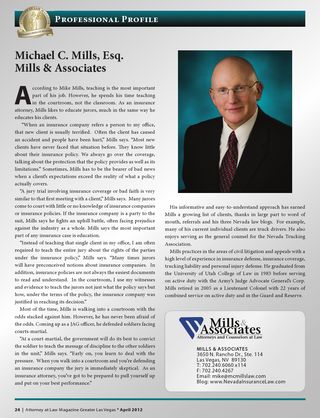 As Defendant Driver VanVeen was exiting the I-15 at Charleston, he failed to slow his tractor trailer sufficiently. His truck hit the back of the Plaintiffs’ car. The truck scraped the side of the car and kept ongoing. The car followed the truck. As the truck tried to merge to the left lane it hit the car again because the car was in the truck’s blind spot. The truck then stopped.
As Defendant Driver VanVeen was exiting the I-15 at Charleston, he failed to slow his tractor trailer sufficiently. His truck hit the back of the Plaintiffs’ car. The truck scraped the side of the car and kept ongoing. The car followed the truck. As the truck tried to merge to the left lane it hit the car again because the car was in the truck’s blind spot. The truck then stopped.
In Hernandez v. VanVeen, No. 2:14-CV-1493 JCM (CWH), 2017 U.S. Dist. LEXIS 161886 (D. Nev. Sep. 29, 2017), the Plaintiffs filed suit and prayed for punitive damages against the truck driver for leaving the scene of the accident.
At the conclusion of discovery, the Defendant filed a Motion for Summary Judgment regarding the claim for punitive damages.
Relying on Terrell v. Central Wash. Asphalt, Inc., 168 F. Supp. 3d 1302, 1318 (D. Nev. 2016), Plaintiffs argued that Defendant’s departure from the scene was enough to support Plaintiffs’ claim for punitive damages. However, the Court disagreed.
Instead, the Court agreed with Defendant’s arguments that even if the driver had intended to flee the scene, there was no evidence that the driver did so with oppression, fraud or malice, either express or implied. The distinction was that in Terrell, the plaintiff presented sufficient evidence of oppression, fraud, or malice when defendant knowingly violated hours-of-service regulations, attempted a dangerous passing maneuver in the dark, caused a major accident, and fled the scene. The judge said that that was sufficient evidence of oppression otherwise defined as conscious disregard of the rights or safety of others this causing the issue of punitive damages to be submitted to the jury.
If you have any questions about Nevada Trucking Law, Nevada Insurance Law or punitive damages, please contact Mike Mills at Bauman Loewe Witt & Maxwell. He can be reached at 702.240.6060 x114. You can also email him at mmills@blwmlawfirm.com.
 Follow
Follow Email
Email


